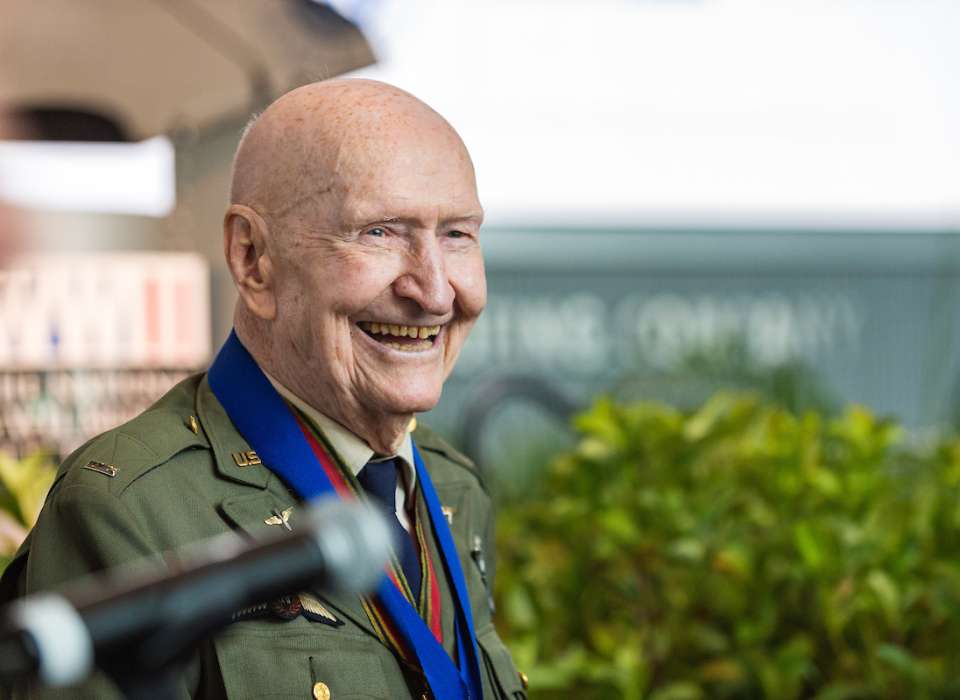The National WWII Museum is saddened to learn of the passing of Colonel Gail S. Halvorsen (USAF, Ret.), who died February 16, 2022, at the age of 101. Famously known as the “Candy Bomber,” Halvorsen proudly served in the US Army Air Force and US Air Force for 30 years. He leaves behind an incredible legacy of kindness and compassion that stands as a true testament to humanitarianism, even in times of conflict and uncertainty.
Halvorsen was born in Salt Lake City, Utah in October 1920, and he grew up in Garland, Utah. As a young man, he competed for, and earned a scholarship for private flying lessons. He loved to fly and soon earned his private flying license as a teenager.
Following the entry of the United States in the Second World War and the subsequent mobilization, Gail signed up for the Army Air Force in 1942. He went on active duty in 1943. Because he already had his private pilot’s license, opportunities immediately opened up, and Halvorsen was offered a slot training fighter pilots of Britain’s Royal Air Force (RAF). He immediately volunteered for the mission. In the process, he received his RAF wings as a fighter pilot.
Although Gail had the makings of an exceptional fighter pilot, the Army Air Forces had their own needs. The Army Air Forces had an imbalance, and rather than assignment as a fighter pilot, Halvorsen was assigned to pilot transport aircraft. He flew C-54s, the Douglas Skymaster, for the remainder of the war. Beginning in 1944, he flew cargo and transport missions from Brazil to Ascension Island and Africa.
After the war he decided to remain in the Army Air Force and stayed in the US Air Force when it became a separate service in 1947.
Variously known as “Candy Bomber,” “Chocolate Pilot,” or “Uncle Wiggly Wings,” Halvorsen earned those nicknames during his service as a command pilot during the Berlin Airlift, which lasted from June 1948 until September 1949. During that period, the Soviet Union imposed a blockade on the zones of Berlin under the control of the United States, Britain, and France. As a result of the Soviet blockade, nearly 2.5 million German civilians had no access to medicine, fuel, and food. It quickly became the first major international crisis in the Cold War.
Although not originally assigned to the Berlin mission, Halvorsen volunteered to take the place of his best friend, whose wife had just given birth to a new baby.
In his oral history with the Museum, Halvorsen admitted he was apprehensive about providing aid to his former enemies, especially since he still mourned the loss of friends who were killed by the Nazis. After witnessing the gracious faces of West Berliners, however, Halvorsen’s anger and trepidation vanished. “I couldn’t wait to get that food on the ground to support the women and children of West Berlin,” he recalled. “[The war] wasn’t their fault, it was Hitler’s.”
During one mission, Halvorsen shared two sticks of gum with children waiting along the fences of the airfield where US planes landed to unload food and coal. After seeing the joy in their faces, he began asking his fellow servicemen for their chocolate and gum rations. He tied those pieces of chocolate and gum to handkerchiefs so he could drop little parachutes of candy out of his plane for the children of West Berlin.
Halvorsen’s actions were unprecedented and done without permission. There, of course, were concerns about what the brass would say. Nonetheless, when his commanding officer found out, he ordered Halvorsen to keep it up. The operation was eventually expanded to include entire boxes of candy tied to parachutes, leaving Halvorsen forever immortalized as the “Candy Bomber” and “Chocolate Pilot.”
Halvorsen promised a group of children that he would drop candy to them from his plane the next time he flew over. However, because there were many American airplanes that passed over Berlin carrying supplies during the blockade, one girl was skeptical. “How will we know your plane?” she asked Halvorsen. “I will wiggle my wings,” he replied, and the name “Uncle Wiggly Wings” stuck.
After being reassigned to the United States, Halvorsen enrolled at the University of Florida and earned a degree in Aeronautical Engineering. Originally Halvorsen had intended to leave the service and start his own business, but the Air Force convinced him to stay in the service by offering to send him to school. So Halvorsen stayed on and made the Air Force a career. He worked in research development at the Wright Air Development Center in Dayton, Ohio and for the space program in Los Angeles, California.
It is fitting that the “Candy Bomber” returned to Berlin at the twilight of his career. He was assigned as the commander of Tempelhof Air Base in Berlin from 1970-1974.
Over the years, Halvorsen often reflected how those Berlin children taught him the importance of freedom. Halvorsen worked closely with the Berlin Airlift Historical Foundation as a way to share his story of kindness and the value of serving others. “Genuine happiness…real happiness, soul-enriching happiness comes from service before self,” Halvorsen said in his oral history. “Serving someone else is the only real way of getting outside of oneself.”
True to form, in 2005, Halvorsen brought his special brand of care, and some candy, to victims of Hurricane Katrina in 2005. In 2019, the National WWII Museum honored Halvorsen with its Silver Service Medallion for his lifetime of service.
The National WWII Museum mourns the loss of Halvorsen and extends our deepest sympathies to his family and friends. We salute his compassion and humanity, traits exemplified in his fame as “Candy Bomber” and “Uncle Wiggly Wings” amid the Cold War’s first major international crisis, the Berlin Airlift. We are honored to have his remarkable story of courage and compassion documented in our oral history collection as a permanent tribute to his service and his legacy.
